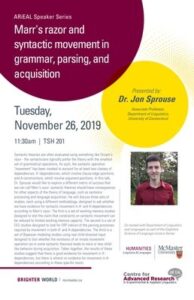Dr. Jon Sprouse, November 26, 11:30 am to 1 pm
ARiEAL is pleased to invite Dr. Jon Sprouse, one of our Scientific Advisory Committee members, to present a talk at the ARiEAL Speaker Series in November. This talk is co-hosted with Department of Linguistics and Languages as part of the Cognitive Science of Language Lecture Series. Dr. Sprouse is an Associate Professor in the Department of Linguistics, University of Connecticut. He is an experimental syntactician. His research starts from two working hypotheses: (i) that there is an underlying combinatorics to human language syntax, and (ii) that this combinatorics is implemented in the human brain. Dr. Sprouse takes the goal of theoretical syntax to be to map out the hypothesis space of possible combinatorial systems that could be implemented in the brain (at some level of abstraction). And he takes the goal of experimental syntax to be to find whatever evidence we can to help shift probability mass around in that hypothesis space. To that end, Dr. Sprouse tries to leverage as many useful methods as possible in his research, such as acceptability judgments, EEG, fMRI, and even computational modeling.
Title: Marr’s razor and syntactic movement in grammar, parsing, and acquisition
Presenter: Dr. Jon Sprouse
Date: Tuesday, November 26, 2019
Time: 11:30 am to 1:00 pm
Location: TSH 201, McMaster University

Expandable List
Syntactic theories are often evaluated using something like Occam’s razor – the syntacticians typically prefer the theory with the smallest set of grammatical operations. As such, the syntactic operation “movement” has been invoked to account for at least two classes of dependencies: A’-dependencies, which involve clause-edge positions; and A-constructions, which involve argument positions. In this talk, Dr. Sprouse would like to explore a different metric of success that we can call Marr’s razor: syntactic theories should have consequences for other aspects of the theory of language, such as sentence processing and language acquisition. He will discuss three sets of studies, each using a different methodology, designed to ask whether we have evidence for syntactic movement in A’ and A-dependencies according to Marr’s razor. The first is a set of working memory studies designed to test the claim that constraints on syntactic movement can be reduced to limited working memory capacity. The second is a set of EEG studies designed to look for ERP indices of the parsing processes required by movement in both A’ and A-dependencies. The third is a set of Bayesian modeling studies using real child-directed input designed to test whether the existence of an innate movement operation (as in some syntactic theories) leads to more or less childlike behavior during acquisition. Taken together, the results of these studies suggest that there is good evidence for movement in A’- dependencies, but there is almost no evidence for movement in Adependencies (according to these specific tests).

